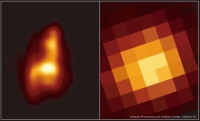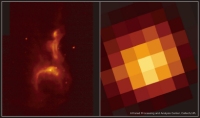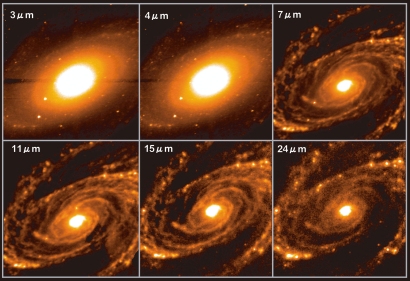AKARI First Light
22 May 2006
AKARI, the new Japanese infrared sky surveyor mission in which ESA is participating, saw first light on 13 April 2006 (UT). The first images were taken towards the end of a successful checkout of the spacecraft in orbit.The mission, formerly known as ASTRO-F, was launched on 21 February 2006 (UT) from the Uchinoura Space Centre in Japan. Two weeks after launch the satellite reached its operational Sun-synchronous polar orbit around Earth at an altitude of approximately 700 kilometres.
 |
 |
|
IC4954 seen by FIS at 90 μm (top) and IRC at 9 μm (bottom) |
AKARI's two instruments were pointed toward the reflection nebula IC4954, situated about 6000 light years away and extending more than 10 light years across. In these infrared images of IC4954 - a region of intense star formation - it is possible to pick out individual stars that have only recently been born. They are embedded in gas and dust and cannot be seen in visible light. It is also possible to see the gas clouds from which these stars were created.
For comparison, the images of IC4954 as obtained with the InfraRed Astronomical Satellite (IRAS) are shown alongside. Clearly visible is the improvement in sensitivity and resolution of the AKARI instruments compared to IRAS, which will now allow for the discovery and study of fainter sources and more distant objects in the infrared.
With the IRC, AKARI also imaged the spiral galaxy M81 - located about 12 million light years away - at six different wavelengths. The images taken at 3 and 4 μm show the distribution of stars in the inner part of the galaxy, without any obscuration from the intervening dust clouds. At 7 and 11 μm the images show the radiation from organic materials in the galaxy's interstellar gas. The distribution of the dust heated by young hot stars can be seen in the images at 15 and 24 μm, showing that the star forming regions sit along the spiral arms of the galaxy.
 |
|
Spiral galaxy M81, seen at 6 wavelengths by the IRC |
Having concluded all in-orbit checks, AKARI is now entering the first mission phase. This will last about six months and is aimed at performing a complete survey of the entire sky at several wavelength bands in the infarred. This part of the mission will then be followed by a phase during which thousands of selected astronomical targets will be observed in detail. During this second phase, as well as in the following third phase in which only the infrared camera will be at work, European astronomers will have access to ten percent of the overall pointed observation opportunity.
The new data will be of enormous value to plan follow-up observations of the most interesting celestial objects with ESA's future infrared observatory, Herschel.
Note to editors
AKARI is the result of an international effort. It was developed by the Japan Aerospace Exploration Agency (ISAS/JAXA), with the participation of Japanese universities and institutes. Including Seoul National University, South Korea, the project also draws on the involvement of ESA and a consortium of UK universities (Imperial College, London; The Open University & the University of Sussex) funded by the Particle Physics and Astronomy Research Council (PPARC), as well as the Netherlands Institute for Space Research and Groningen University (NL).
ESA/ESAC provides expertise and support for the sky-survey data processing, through the pointing reconstruction – this allows the determination of accurate astronomical positions for each of the new sources discovered. ESAC also provides user support for the observing opportunities distributed to European astronomers. ESA/ESOC is providing the mission with ground support through its ground station in Kiruna, for several passes per day.
Launched in 1983, the InfraRed Astronomical Satellite (IRAS) was the first mission to make a complete infrared survey of the entire sky. The mission resulted from the joint venture between the USA, United Kingdom, and the Netherlands.

